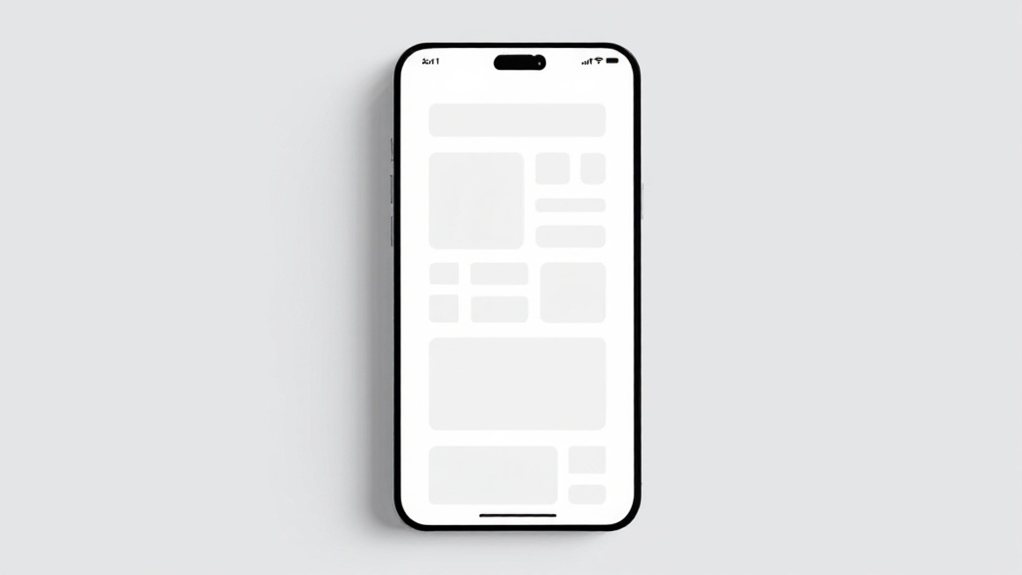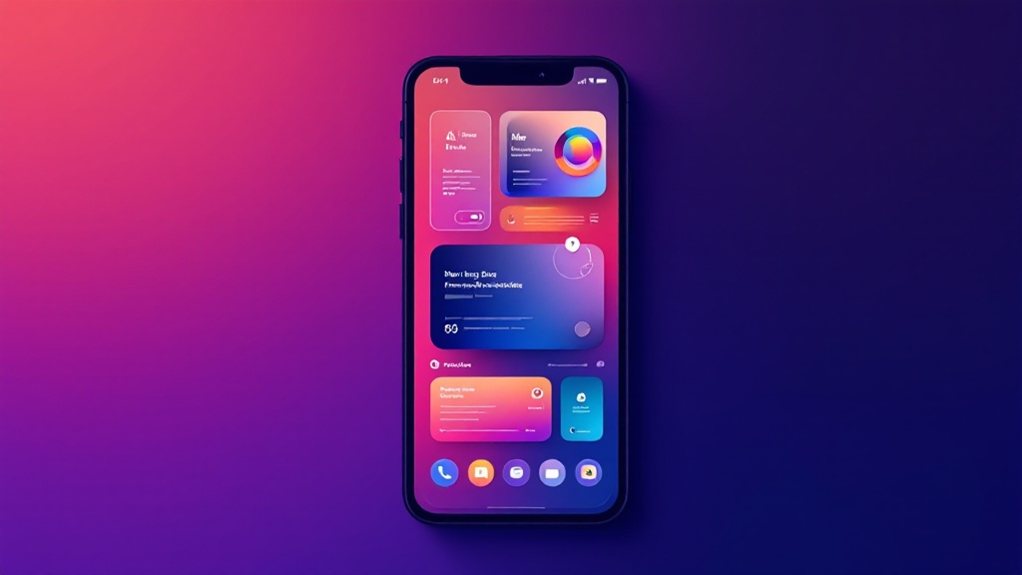As a web design consultant, you'll need to prioritize a mobile-first approach, optimizing for smaller screens, streamlining navigation, and enhancing page load times. Leverage responsive techniques to ensure seamless experiences across devices, and incorporate intuitive UI elements while maintaining content accessibility. Continuously analyze user behavior and feedback, testing and iterating on your solutions – this will help you stay ahead of the curve in today's mobile-driven digital landscape.
Key Takeaways
- Start with a mobile-first mindset and progressively enhance for larger screens to ensure exceptional user experience across devices.
- Streamline navigation, minimize clutter, and optimize media and typography for faster loading times and enhanced accessibility on smaller screens.
- Leverage responsive web design techniques to create a seamless and adaptive experience that adapts to various screen sizes.
- Optimize for thumb-driven interactions by placing critical buttons and links within reach and simplifying form fields and checkout processes.
- Regularly audit website performance and address bottlenecks to maintain fast load times and keep users engaged.
Prioritize Mobile-First Design

As mobile devices continue to dominate web usage, prioritizing a mobile-first design approach has become paramount. This means starting with the mobile experience and then progressively enhancing for larger screens. By designing for the smallest viewport first, you can ensure your content and functionality are optimized for the most constrained environment. This mobile-centric mindset should permeate every aspect of your web design, from information architecture to interactive elements. Remember, a mobile-first approach isn't just about creating a responsive layout – it's about crafting an exceptional user experience tailored to the unique needs and behaviors of mobile users.
Optimize for Smaller Screens
When designing for smaller screens, you must prioritize simplicity and focus. Avoid clutter and ensure key information is easily accessible. Streamline navigation, limit unnecessary content, and leverage responsive design techniques to ensure a seamless experience across devices. Optimize images, videos, and other media for faster loading times. Utilize clear, legible typography and consider touch-friendly UI elements. Minimize the need for scrolling and pinching-and-zooming. Thoroughly test your designs on various mobile devices and screen sizes to identify and address usability issues. By optimizing for smaller screens, you can create a mobile-centric website that engages and delights your users, regardless of the device they're using.
Streamline Navigation and Interactions

Streamlining navigation and interactions is key when designing a mobile-centric website. Ensure your navigation is intuitive and easy to use on smaller screens. Optimize for thumb-driven interactions, placing critical buttons and links within easy reach. Minimize form fields and simplify checkout processes. Leverage progressive disclosure to reveal content and functionality only when needed, reducing clutter. Incorporate gestures like swiping and tapping to enhance the mobile experience. Analyze user behavior and iterate based on feedback to continuously improve navigation and interactions. Remember, seamless mobile usability can make or break your website's success.
Enhance Page Load Times
Given the importance of mobile-centric web design, enhancing page load times is crucial. Optimize images, minify CSS and JavaScript, and leverage browser caching to shave seconds off your load times. Prioritize the critical rendering path and eliminate unnecessary assets. Employ techniques like lazy loading and code splitting to further boost performance. Regularly audit your site and address any bottlenecks. Maintaining fast load times keeps users engaged and reduces bounce rates. The mobile experience must be lightning-fast to stay competitive. Continually monitor and refine your page load optimization efforts for optimal results.
Leverage Responsive Web Design

As you optimize your site's performance, leveraging responsive web design is a crucial next step. By embracing a responsive approach, you can ensure your website adapts seamlessly to various screen sizes, from smartphones to desktops. This flexibility enhances the user experience, allowing your audience to access your content effortlessly, regardless of their device. Responsive design also simplifies maintenance, as you'll only need to update a single codebase. Additionally, it can improve your search engine visibility, as Google prioritizes mobile-friendly websites. Incorporate responsive techniques like flexible layouts, adaptable images, and media queries to deliver a consistent, high-quality experience across all devices. This holistic approach will elevate your mobile-centric strategy and keep your users engaged.
Optimize for Touch-Based Interactions
Now that you've optimized your site's performance through responsive web design, the next step is to focus on optimizing for touch-based interactions. Ensure your interface is finger-friendly with ample spacing between clickable elements. Prioritize simple, intuitive navigation and minimize the need for precise tapping. Leverage larger font sizes and buttons that are easy to hit. Adapt your content for seamless scrolling and swiping on mobile devices. Avoid relying on hover-based interactions, which don't translate well to touch screens. Test your designs thoroughly on real mobile devices to identify and address any usability issues. By prioritizing touch-centric design, you'll create a delightful mobile experience that keeps users engaged and coming back.
Incorporate Intuitive UI Elements

How can you incorporate intuitive UI elements to enhance the mobile experience? Design with a mobile-first approach, prioritizing simplicity and ease of use. Leverage familiar gestures like swiping, tapping, and pinching to navigate your interface. Ensure key actions are within thumb's reach for one-handed operation. Minimize clutter by grouping related functions and hiding secondary features behind menus. Leverage visual cues like icons, labels, and microcopy to guide users. Prioritize responsive layouts that adapt seamlessly to various screen sizes. By implementing these intuitive UI principles, you'll create a delightful mobile experience that keeps users engaged and productive on the go.
Ensure Content Accessibility
Ensuring content accessibility is crucial for providing a seamless mobile experience. Optimize your content for easy scanning and readability on smaller screens. Use clear, concise language, and break up text with subheadings, bullet points, and paragraphs. Ensure that your images, videos, and other media are properly labeled and accessible to users with disabilities. Leverage responsive design techniques to ensure that your content adapts to various screen sizes and device orientations. Additionally, consider implementing accessibility features like zoom functionality, high-contrast options, and keyboard navigation. By prioritizing content accessibility, you'll create a mobile-friendly experience that caters to a diverse audience and enhances your overall website usability.
Analyze User Behavior and Feedback

To optimize your mobile-centric design, you'll need to thoroughly analyze user behavior and feedback. Track metrics like bounce rate, time on page, and conversion rates to identify pain points. Conduct user testing to observe how people interact with your site on mobile devices. Gather feedback through surveys and user interviews to understand their needs and frustrations. Analyze this data to make informed decisions about your design, content, and functionality. Continuously monitor and refine your approach based on evolving user behaviors and preferences. Leveraging these insights will help you create a mobile experience that truly resonates with your audience.
Continuously Test and Iterate
Continuous testing and iteration are essential for fine-tuning your mobile-centric design. As you implement your strategies, regularly gather user feedback and analyze how they interact with your site. Don't be afraid to experiment – try different layouts, content formats, and navigation structures to see what resonates best. Analyze metrics like bounce rate, time on page, and conversion rates to identify areas for improvement. Be prepared to make quick adjustments based on this data. Continuously refine your design, responding to evolving user needs and market trends. This agile approach ensures your mobile experience stays ahead of the curve and delivers maximum value to your audience.

